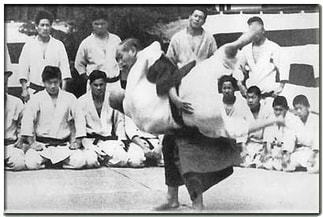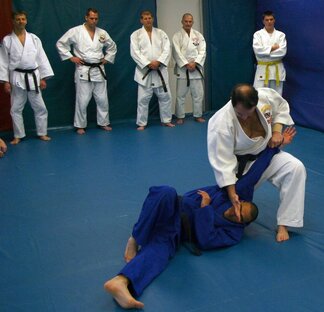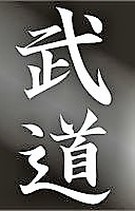 Jigoro Kano Teaching Uki Goshi
Jigoro Kano Teaching Uki Goshi
The Art of Kodokan Judo
NATURE OF THE ART
In order to fully understand the nature of Judo, it is necessary to consider two things: the founder, Jigoro Kano, and the prototype of Judo, Jujitsu.
Professor Jigoro Kano (1860-1939), founder of Kodokan Judo, was born in the seaside town of Mikage near Kobe, Japan. He was graduated from the Literary College of the Imperial University, Tokyo, and Oxford University, London, England, and devoted his life to education being the Director of the Bureau of Primary and Secondary Education for all of Japan, and was for twenty-four years President of the Higher Normal College in Tokyo.
Professor Kano was an authority on physical culture. In 1913 he organized the Japan Physical Culture Society. In 1909 he was appointed a member of International Olympic Committee; he was the first Japanese ever to hold this position. It is largely due to his initiative and enterprise that Judo has come to assume its present importance as an international sport.
He also devoted careful consideration to moral training as well as to technical instruction. In a lecture on the principles of Judo and their application to all phases of human activity given at the Parnassus Society at Athens, Greece, Professor Kano stated:
"First of all moral culture must be pursued from the intellectual side, enabling a man to know what is right and what is wrong and also enabling him to reason out and decide this even under complicated circumstances. At the same time cultivation of the emotional and volitional power, as well as the importance of forming good habits, must not be forgotten. But very few people seem to study these things seriously. This, I believe, is also due to the lack of recognition of the Principle of Maximum Efficiency."
Just how did Jigoro Kano happen to interest himself in physical arts of self-defense? The question is simply answered. A proud boy of no sizable physique, smarting under the bullying of bigger companions, he desired to be able to defend himself. On hearing of techniques of throwing, stabbing, kicking, choking, and twisting the joints, he at once made up his mind to learn it. After many years of study under numerous masters of Jujitsu, Professor Kano achieved great proficiency. Recognizing that the forms were most effective for training both the mind and body, and yet, many techniques were violent and dangerous Professor Kano was not content with his accomplishments. And, further realizing the lack of a fundamental principle, professor Kano conceived of one all pervading principle – "Whatever be the object, it can best be achieved by the highest or the maximum efficient use of mental and physical energy directed to that purpose or aim." Forthwith, he studied anew all the methods of attack and defense taught by the different masters. He then found there were many methods, which could stand this test while many others could not. Preserving those which he deemed valid and adding many others of his own device, Professor Kano organized in 1882 his own system of attack and defense. "Judo" is the name of this fundamental principle, whereas Jujitsu is the name for a group of different devices not founded on such principle. Professor Kano demonstrated that Judo – in marked contrast to Jujitsu – could, if desired, be indulged in purely as a sport free from danger. He further named the institution where this principle is studied and its application taught, KODOKAN, which literally means "an institution for studying the way." The founder’s precept as it is being taught throughout the world today includes the following:
Judo is a way of applying most effectively one’s energy, physical and mental. The secret of the art is to be mastered by training and cultivating both body and mind through exercises in the prescribed methods of offense and defense. And, thereby, we may perfect ourselves and contribute to the welfare of mankind, which is the ultimate aim of Judo.
It is the above teaching, which has been summarized in the slogans: "Best use of energy" and "Common well-being for one and all."
"Best use of energy" is not particularly novel or startling as a phrase. But, it was only after long years of Judo training and practice that Professor Kano arrived at a full comprehension of the principle. He explains its deeper meaning: "It is a basic principle of Judo to utilize most effectively the strength of both body and spirit." However, it does not apply to the technique of offense and defense alone. "It is the most important basic principle for doing any and all thing in the world. Nothing can be accomplished successfully unless one uses one’s strength of body and mind to the best advantage."
The second principle: "Common well being for all." Judo is fundamentally an art of combat and its object is to win by overthrowing your adversary. In that sense, this principle of well being for one and all may sound incongruous and far fetched. But common well being for both yourself and opponent is an ideal of the Kodokan Judo – the supreme ideal that is attained only by those who, having mastered the art, transcend all notions of victory and defeat. According to Professor Kano, the ultimate aim of Judo is to perfect yourself and to contribute to the well being of mankind.
Kanzo Uchimura, the famous Christian leader of the Meiji Era, applied this further:
"The perfection of self can only be achieved through constant striving and through dedication to art until ego is completely eliminated from one’s life, and self and society become one."
Nowhere will you find a better means of attaining this end than through the study of a sport that is practiced as an art, Judo.
(Extract from the Text - Kodokan Judo Illustrated)
NATURE OF THE ART
In order to fully understand the nature of Judo, it is necessary to consider two things: the founder, Jigoro Kano, and the prototype of Judo, Jujitsu.
Professor Jigoro Kano (1860-1939), founder of Kodokan Judo, was born in the seaside town of Mikage near Kobe, Japan. He was graduated from the Literary College of the Imperial University, Tokyo, and Oxford University, London, England, and devoted his life to education being the Director of the Bureau of Primary and Secondary Education for all of Japan, and was for twenty-four years President of the Higher Normal College in Tokyo.
Professor Kano was an authority on physical culture. In 1913 he organized the Japan Physical Culture Society. In 1909 he was appointed a member of International Olympic Committee; he was the first Japanese ever to hold this position. It is largely due to his initiative and enterprise that Judo has come to assume its present importance as an international sport.
He also devoted careful consideration to moral training as well as to technical instruction. In a lecture on the principles of Judo and their application to all phases of human activity given at the Parnassus Society at Athens, Greece, Professor Kano stated:
"First of all moral culture must be pursued from the intellectual side, enabling a man to know what is right and what is wrong and also enabling him to reason out and decide this even under complicated circumstances. At the same time cultivation of the emotional and volitional power, as well as the importance of forming good habits, must not be forgotten. But very few people seem to study these things seriously. This, I believe, is also due to the lack of recognition of the Principle of Maximum Efficiency."
Just how did Jigoro Kano happen to interest himself in physical arts of self-defense? The question is simply answered. A proud boy of no sizable physique, smarting under the bullying of bigger companions, he desired to be able to defend himself. On hearing of techniques of throwing, stabbing, kicking, choking, and twisting the joints, he at once made up his mind to learn it. After many years of study under numerous masters of Jujitsu, Professor Kano achieved great proficiency. Recognizing that the forms were most effective for training both the mind and body, and yet, many techniques were violent and dangerous Professor Kano was not content with his accomplishments. And, further realizing the lack of a fundamental principle, professor Kano conceived of one all pervading principle – "Whatever be the object, it can best be achieved by the highest or the maximum efficient use of mental and physical energy directed to that purpose or aim." Forthwith, he studied anew all the methods of attack and defense taught by the different masters. He then found there were many methods, which could stand this test while many others could not. Preserving those which he deemed valid and adding many others of his own device, Professor Kano organized in 1882 his own system of attack and defense. "Judo" is the name of this fundamental principle, whereas Jujitsu is the name for a group of different devices not founded on such principle. Professor Kano demonstrated that Judo – in marked contrast to Jujitsu – could, if desired, be indulged in purely as a sport free from danger. He further named the institution where this principle is studied and its application taught, KODOKAN, which literally means "an institution for studying the way." The founder’s precept as it is being taught throughout the world today includes the following:
Judo is a way of applying most effectively one’s energy, physical and mental. The secret of the art is to be mastered by training and cultivating both body and mind through exercises in the prescribed methods of offense and defense. And, thereby, we may perfect ourselves and contribute to the welfare of mankind, which is the ultimate aim of Judo.
It is the above teaching, which has been summarized in the slogans: "Best use of energy" and "Common well-being for one and all."
"Best use of energy" is not particularly novel or startling as a phrase. But, it was only after long years of Judo training and practice that Professor Kano arrived at a full comprehension of the principle. He explains its deeper meaning: "It is a basic principle of Judo to utilize most effectively the strength of both body and spirit." However, it does not apply to the technique of offense and defense alone. "It is the most important basic principle for doing any and all thing in the world. Nothing can be accomplished successfully unless one uses one’s strength of body and mind to the best advantage."
The second principle: "Common well being for all." Judo is fundamentally an art of combat and its object is to win by overthrowing your adversary. In that sense, this principle of well being for one and all may sound incongruous and far fetched. But common well being for both yourself and opponent is an ideal of the Kodokan Judo – the supreme ideal that is attained only by those who, having mastered the art, transcend all notions of victory and defeat. According to Professor Kano, the ultimate aim of Judo is to perfect yourself and to contribute to the well being of mankind.
Kanzo Uchimura, the famous Christian leader of the Meiji Era, applied this further:
"The perfection of self can only be achieved through constant striving and through dedication to art until ego is completely eliminated from one’s life, and self and society become one."
Nowhere will you find a better means of attaining this end than through the study of a sport that is practiced as an art, Judo.
(Extract from the Text - Kodokan Judo Illustrated)

